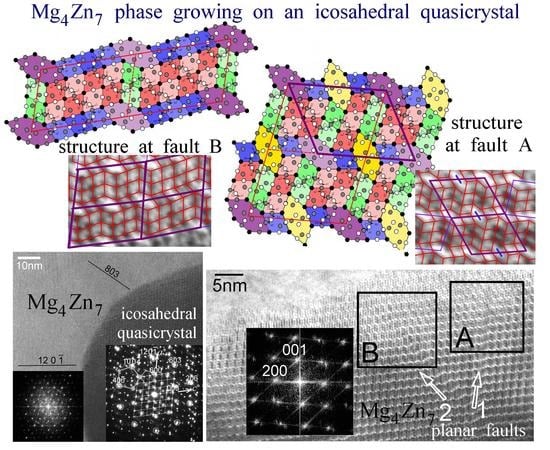Lattice Correspondence and Growth Structures of Monoclinic Mg4Zn7 Phase Growing on an Icosahedral Quasicrystal
Abstract
:1. Introduction
2. Experimental Procedure
3. Results
4. Discussion
4.1. Structural Relationship
- : Since this vector connects adjacent rhomboidal units, (Figure 10) the pseudo lattice parameter was taken as the . This has a magnitude of 12.48 Å, which is approximately . (6 × = 12.96 Å, within 3% of .)
- The line between the centres of rhomboids lies parallel to [100] which is within 3 of the normal to .
- : The normal to the plane lies close to the line connecting one rhomboidal unit with another with co-ordinates -. This vector has magnitude 16.48 Å, equal to and the angle between the normal to the plane is 4.9.
- (023): There is considerable distortion in this direction. The best match between the rhomboidal units and the twofold axis appears to be for the adjacent unit cell with . This at a distance of 5.2 Å, or 2.27 times ; however, there is considerable angular distortion (also visible in the stereo projection).
4.2. Structure at Planar Faults
5. Conclusions
- phase grows on an icosahedral phase with its [010] axis along a fivefold axis of the icosahedral phase, with orientation relationship [010], (803). In the [010] zone axis diffraction pattern, pseudo-fivefold symmetry is generated by (803), (206), (06), ( 0 4) and (12 0 ) spots. These spot correspond to twofold symmetry vectors in the icosahedral lattice.
- Five sets of three nearly-mutually orthogonal planes related to icosahedral twofold symmetry planes have been determined to define near-orthogonal cells. One such cell is defined by ( 0 1)-(11)-(023) set of planes.
- Due to incommensurable crystalline a-c plane with the fivefold icosahedral lattice planes, the lattice exhibited a high density of planar faults in this plane (parallel to its monoclinic axis). These faults were determined to be of two kinds, in {200} and {01} planes. Their structures were determined; the faults altered the unit cell to (i) a = 44.4, b = 5.24, c = 14.3 Å and = 108, and (ii) a = 32.0, b = 5.24, c = 22.7 Å and = 103.
Author Contributions
Acknowledgments
Conflicts of Interest
References
- Shechtman, D.; Blech, I.; Gratias, D.; Cahn, J.W. Metallic Phase with Long-Range Orientational Order and No Translational Symmetry. Phys. Rev. Lett. 1984, 53, 1951–1953. [Google Scholar] [CrossRef]
- Chattopadhyay, K.; Ranganathan, S.; Subbanna, G.N.; Thangaraj, N. Electron microscopy of quasi-crystals in rapidly solidified Al-14%Mn alloys. Scripta Metall. 1985, 19, 767–771. [Google Scholar] [CrossRef]
- Bendersky, L. Quasicrystal with One-Dimensional Translational Symmetry and a Tenfold Rotation Axis. Phys. Rev. Lett. 1985, 55, 1461–1463. [Google Scholar] [CrossRef] [PubMed]
- Schaefer, R.J.; Bendersky, L. Replacement of icosahedral Al-Mn by decagonal phase. Scripta Metall. 1986, 20, 745–750. [Google Scholar] [CrossRef]
- Thangaraj, N.; Subbanna, G.N.; Ranganathan, S.; Chattopadhyay, K. Electron microscopy and diffraction of icosahedral and decagonal quasicrystals in aluminium-manganese alloys. J. Microsc. 1987, 146, 287–302. [Google Scholar] [CrossRef]
- Hiraga, K.; Hirabayashi, M.; Inoue, A.; Masumoto, T. High resolution electron microscopy of AlMnSi icosahedral and AlMn decagonal quasicrystals. J. Microsc. 1987, 146, 245–260. [Google Scholar] [CrossRef]
- Levine, D.; Steinhardt, P.J. Quasicrystals: A New Class of Ordered Structures. Phys. Rev. Lett. 1984, 53, 2477–2480. [Google Scholar] [CrossRef]
- Levine, D.; Steinhardt, P.J. Quasicrystals. I. Definition and structure. Phys. Rev. B 1986, 34, 596–616. [Google Scholar] [CrossRef]
- Elser, V.; Henley, C.L. Crystal and Quasicrystal Structures in AlMnSi Alloys. Phys. Rev. Lett. 1985, 55, 2883–2886. [Google Scholar] [CrossRef] [PubMed]
- Ishihara, K. Periodic and Aperiodic Lattices. Mater. Sci. Forum 1987, 22–24, 223–230. [Google Scholar] [CrossRef]
- Luo, Z.P.; Zhang, S.Q.; Tang, Y.I.; Zhao, D. Quasicrystals in as-cast Mg-Zn-RE alloys. Scripta Metall. Mater. 1993, 28, 1513–1518. [Google Scholar] [CrossRef]
- Tsai, A.P.; Niikura, A.; Inoue, A.; Masumoto, T.; Nishida, Y.; Tsuda, K.; Tanaka, M. Highly ordered structure of icosahedral quasicrystals in Zn-Mg-RE (RE = rare earth metals) systems. Phil. Mag. Lett. 1994, 70, 169–175. [Google Scholar] [CrossRef]
- Sato, T.J.; Abe, E.; Tsai, A.P. Composition and stability of decagonal quasicrystals in the Zn-Mg-rare-earth systems. Philos. Mag. Lett. 1998, 77, 213–219. [Google Scholar] [CrossRef]
- Abe, E.; Sato, T.J. The structure of a Frank-Kasper decagonal quasicrystal in the Zn-Mg-Dy system: Comparison with the Al-Ni-Co system. Phil. Mag. Lett. 1998, 77, 205–211. [Google Scholar] [CrossRef]
- Yi, S.; Park, E.S.; Ok, J.B.; Kim, W.T.; Kim, D.H. Quasicrystals and related approximant phases in Mg-Zn-Y. Micron 2002, 33, 565–570. [Google Scholar] [CrossRef]
- Lebrun, N.; Stamou, A.; Baetzner, C.; Robinson, J.; Pisch, A. Magnesium-Yttrium-Zinc. In Ternary Alloys; Effenberg, G., Aldinger, F., Rogl, P., Eds.; MSI: Stuttgart, Germany, 2001; Volume 18, pp. 702–710. [Google Scholar]
- Clark, J.B.; Zabdyr, L.; Moser, Z. Mg-Zn (Magnesium-Zinc). In Phase Diagrams of Binary Magnesium Alloys; Nayeb-Hashemi, A.A., Clark, J.B., Eds.; ASM International: Materials Park, OH, USA, 1988; pp. 353–364. [Google Scholar]
- Friauf, J.B. The crystal structure of magnesium di-zincide. Phys. Rev. 1927, 29, 34–40. [Google Scholar] [CrossRef]
- Yarmolyuk, Y.P.; Kripyakevich, P.I.; Mel’nik, E.V. Crystal structure of the compound Mg4Zn7. Sov. Phys. Crystallogr. 1975, 20, 329–331. [Google Scholar]
- Yang, Q.B.; Kuo, K.H. A new description of pentagonal Frank-Kasper phases and a possible structural model of the icosahedral phase. Acta Cryst. A 1987, A43, 787–795. [Google Scholar] [CrossRef]
- Singh, A.; Tsai, A.P. Structural characteristics of precipitates in Mg-Zn-based alloys. Scripta Mater. 2007, 57, 941–944. [Google Scholar] [CrossRef]
- Baek, S.Y.; Lee, K.H.; Kim, T.S. HRTEM Study of Precipitation Behavior in Mg-6 wt%Zn-1 wt%Y Alloy. Korean J. Mater. Res. 2008, 18, 362–366. [Google Scholar] [CrossRef]
- Rosalie, J.; Somekawa, H.; Singh, A.; Mukai, T. Structural relationships among MgZn2 and Mg4Zn7 phases and transition structures in Mg-Zn-Y alloys. Philos. Mag. 2010, 90, 3355–3374. [Google Scholar] [CrossRef]
- Singh, A.; Rosalie, J.; Somekawa, H.; Mukai, T. The structure of precipitates in Mg-Zn-Y alloys. Phil. Mag. Lett. 2010, 90, 641–651. [Google Scholar] [CrossRef]
- Kim, W.J.; Hong, S.I.; Lee, K.H. Structural Characterization of Laves-Phase MgZn2 Precipitated in Mg-Zn-Y Alloy. Met. Mater. Int. 2010, 16, 171–174. [Google Scholar] [CrossRef]
- Rosalie, J.M.; Somekawa, H.; Singh, A.; Mukai, T. Orientation relationships between icosahedral clusters in hexagonal MgZn2 and monoclinic Mg4Zn7 phases in Mg-Zn(-Y) alloys. Phil. Mag. 2011, 91, 2634–2644. [Google Scholar] [CrossRef]
- Xie, Y.-P.; Wang, Z.-Y.; Hou, Z.F. The phase stability and elastic properties of MgZn2 and Mg4Zn7 in Mg-Zn alloys. Scripta Mater. 2013, 68, 495–498. [Google Scholar] [CrossRef]
- Li, X.-D.; Ma, H.-T.; Dai, Z.-H.; Qian, Y.-C.; Hu, L.-J.; Xie, Y.-P. First-principles study of coherent interfaces of Laves-phase MgZn2 and stability of thin MgZn2 layers in Mg-Zn alloys. J. Alloys. Comp. 2017, 696, 109–117. [Google Scholar] [CrossRef]
- Singh, A.; Somekawa, H.; Mukai, T. Microstructure and strength of extruded Mg-Zn-Ho alloys. 2017; in press. [Google Scholar]
- Elser, V. Indexing problems in quasicrystal diffraction. Phys. Rev. B 1985, 32, 4892–4898. [Google Scholar] [CrossRef]
- Momma, K.; Izumi, F. Other information about VESTA. VESTA 3 for three-dimensional visualization of crystal, volumetric and morphology data. J. Appl. Crystallogr. 2011, 44, 1272–1276. [Google Scholar] [CrossRef]
- Black, P.J. Structural relationships between intermetallic compounds. Acta Metall. 1956, 4, 172–179. [Google Scholar] [CrossRef]
- Henley, C.L. Crystals and quasicrystals in the aluminum-transition metal system. J. Non-Cryst. Solids 1985, 75, 91–96. [Google Scholar] [CrossRef]
- Kumar, V. An Atomistic Model for the Decagonal Phase of Al-Fe Alloy. Mater. Sci. Forum 1987, 22–24, 283–294. [Google Scholar] [CrossRef]
- Singh, A. Tailoring microstructure of Mg-Zn-Y alloys with quasicrystal and related phases for high mechanical strength. Sci. Technol. Adv. Mater. 2014, 15, 044803. [Google Scholar] [CrossRef] [PubMed]

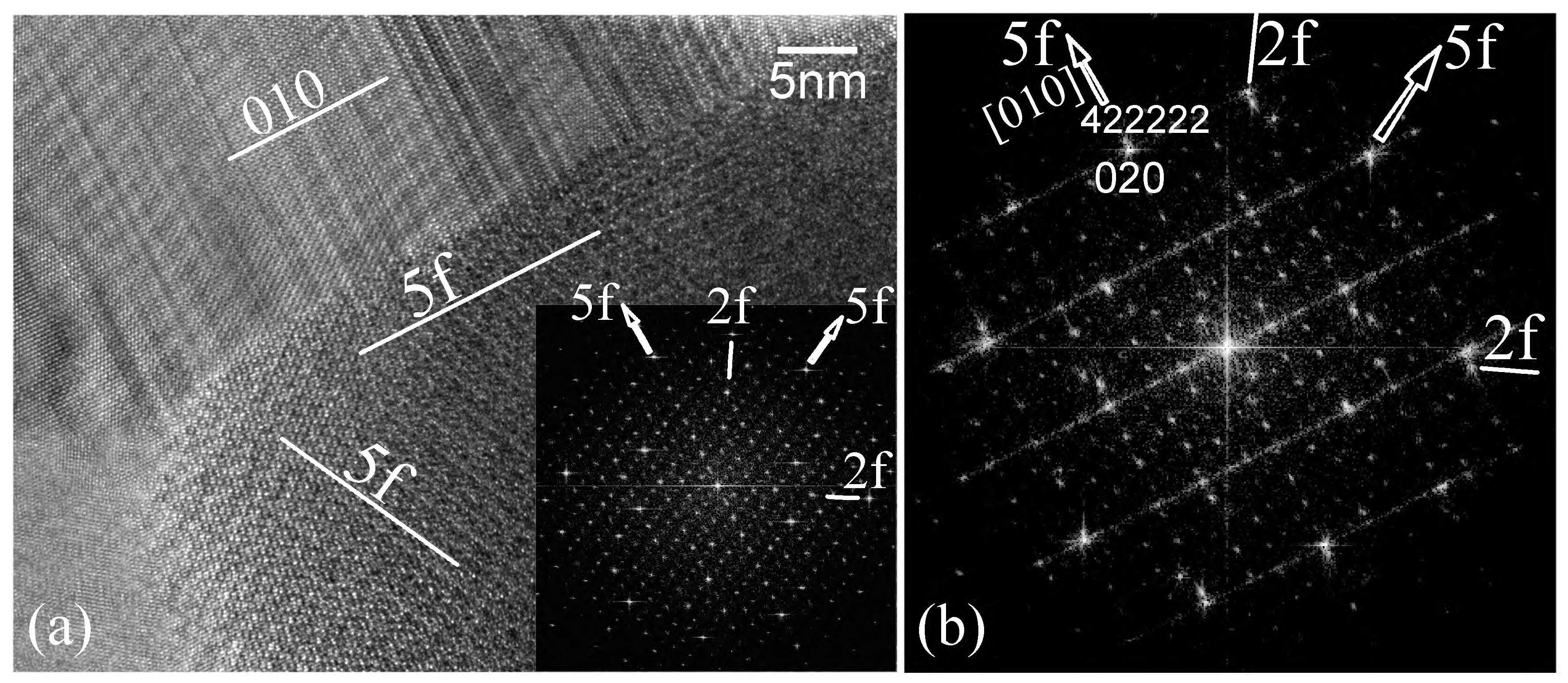
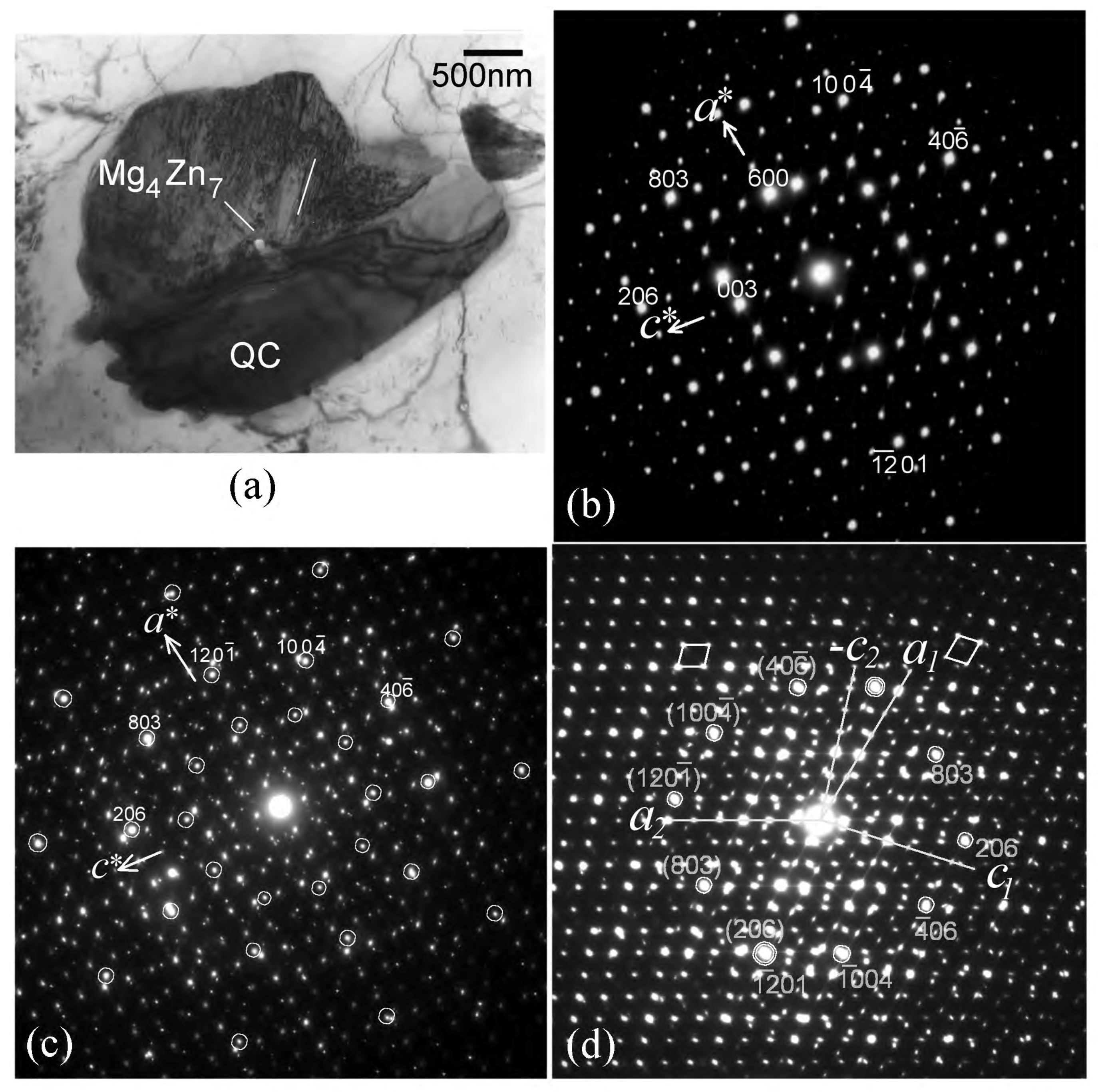
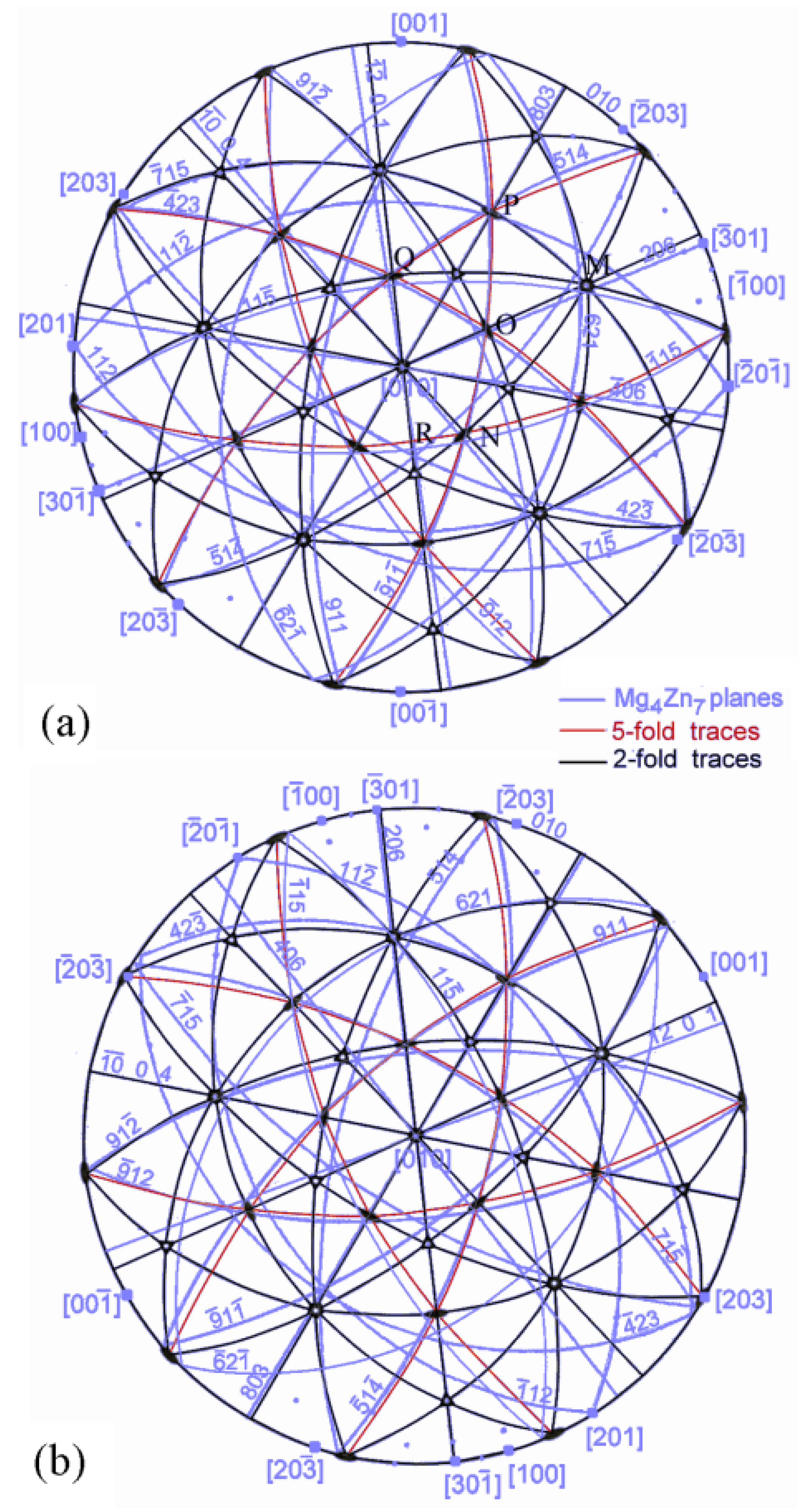
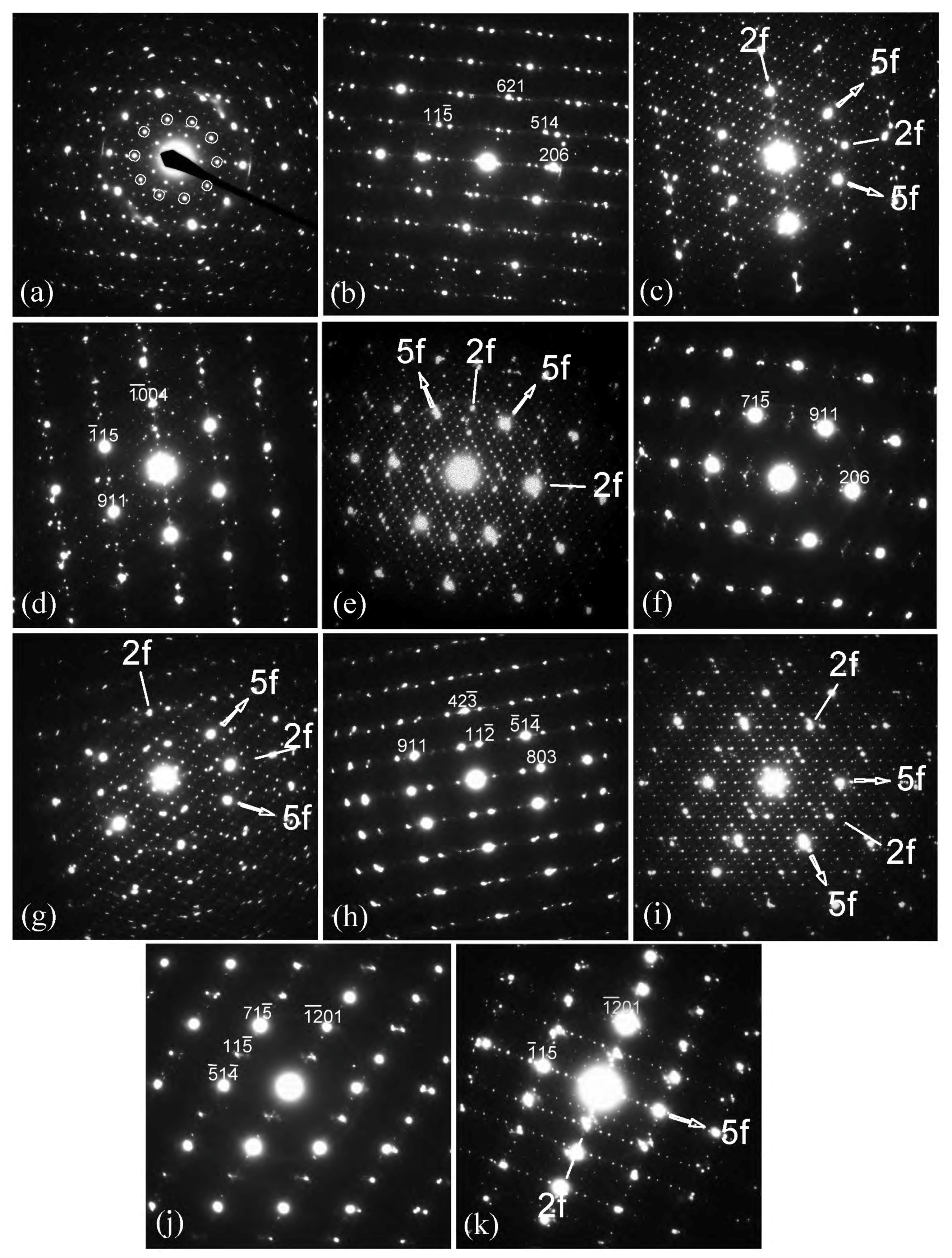
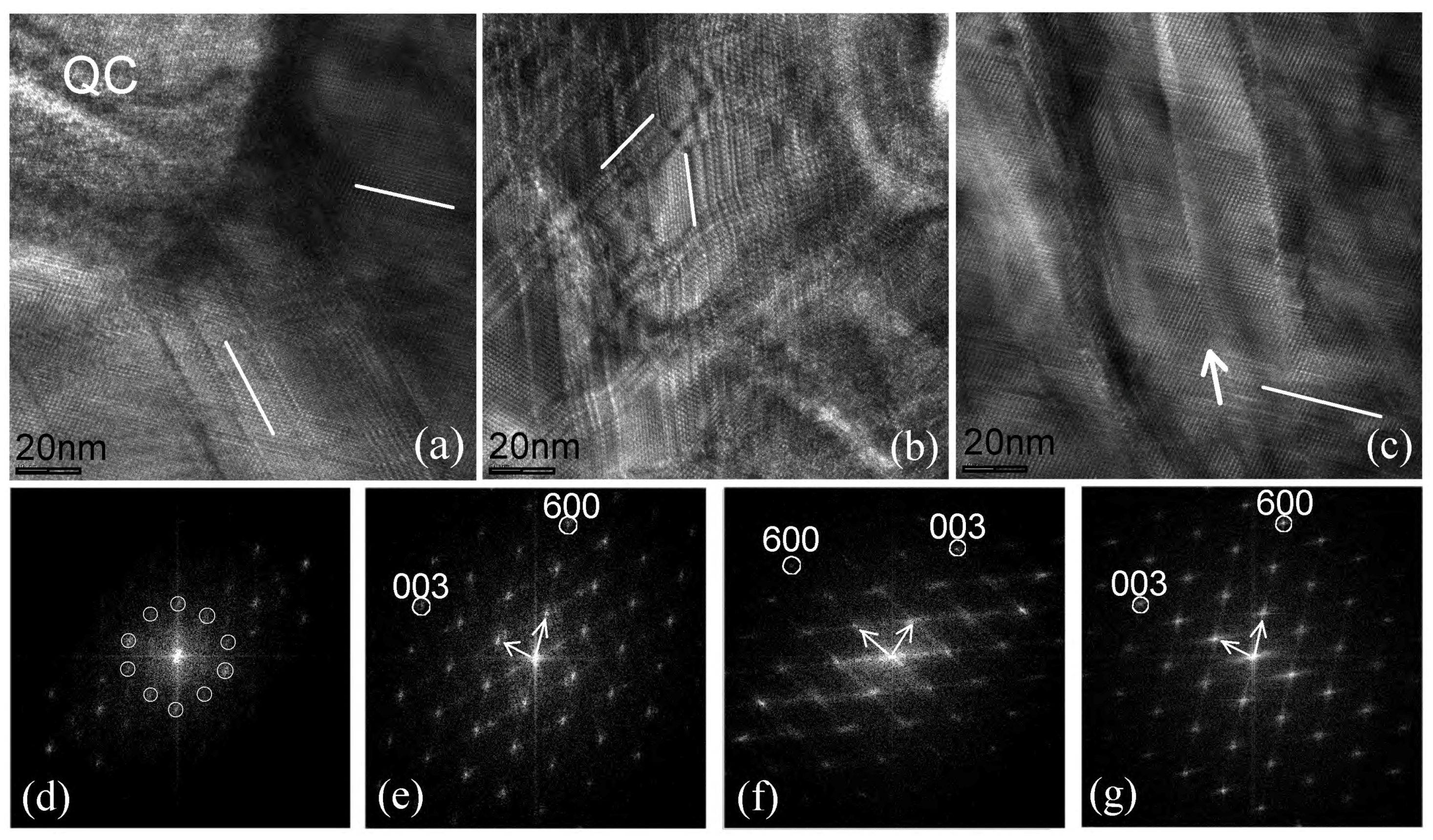
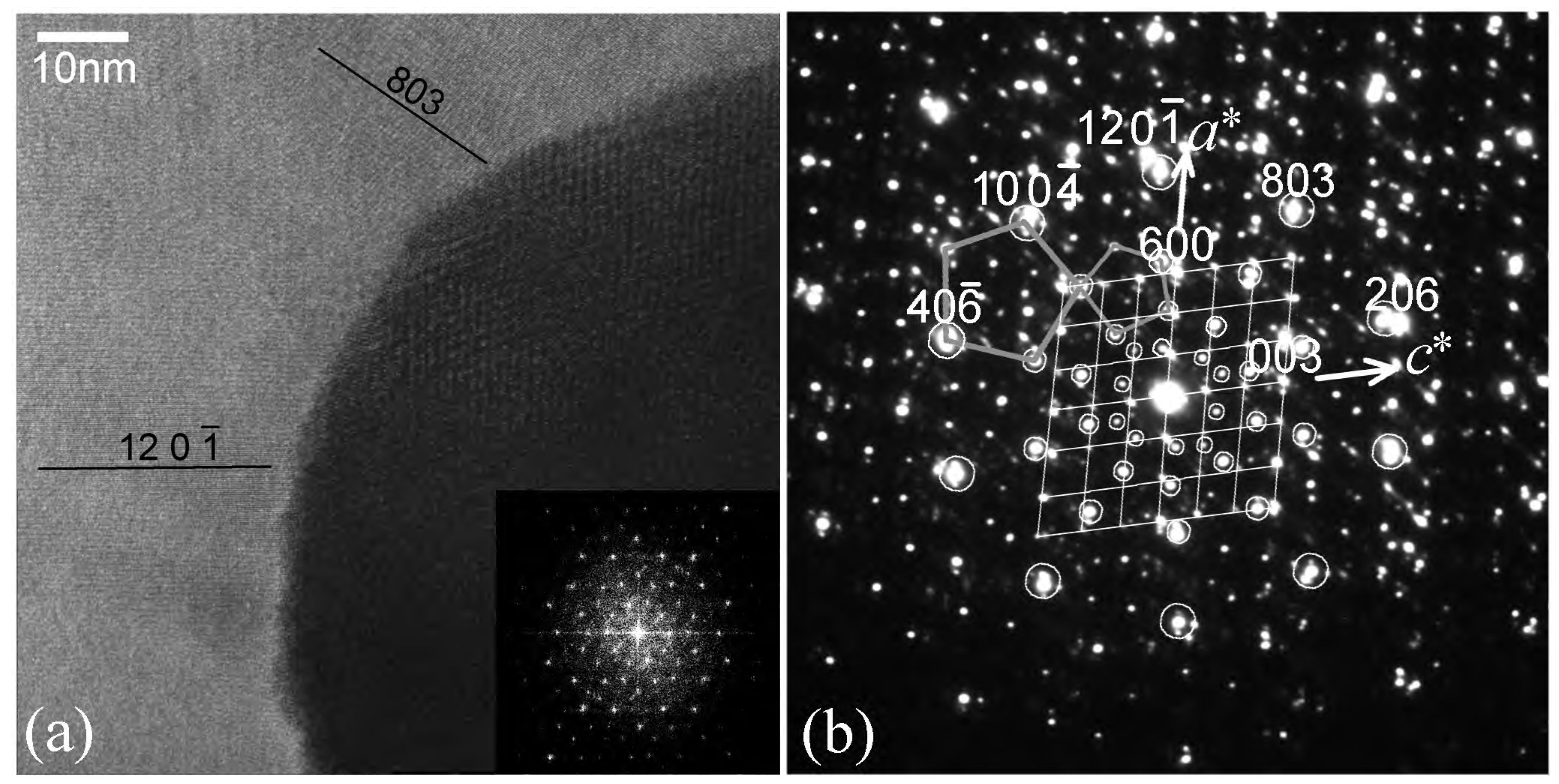
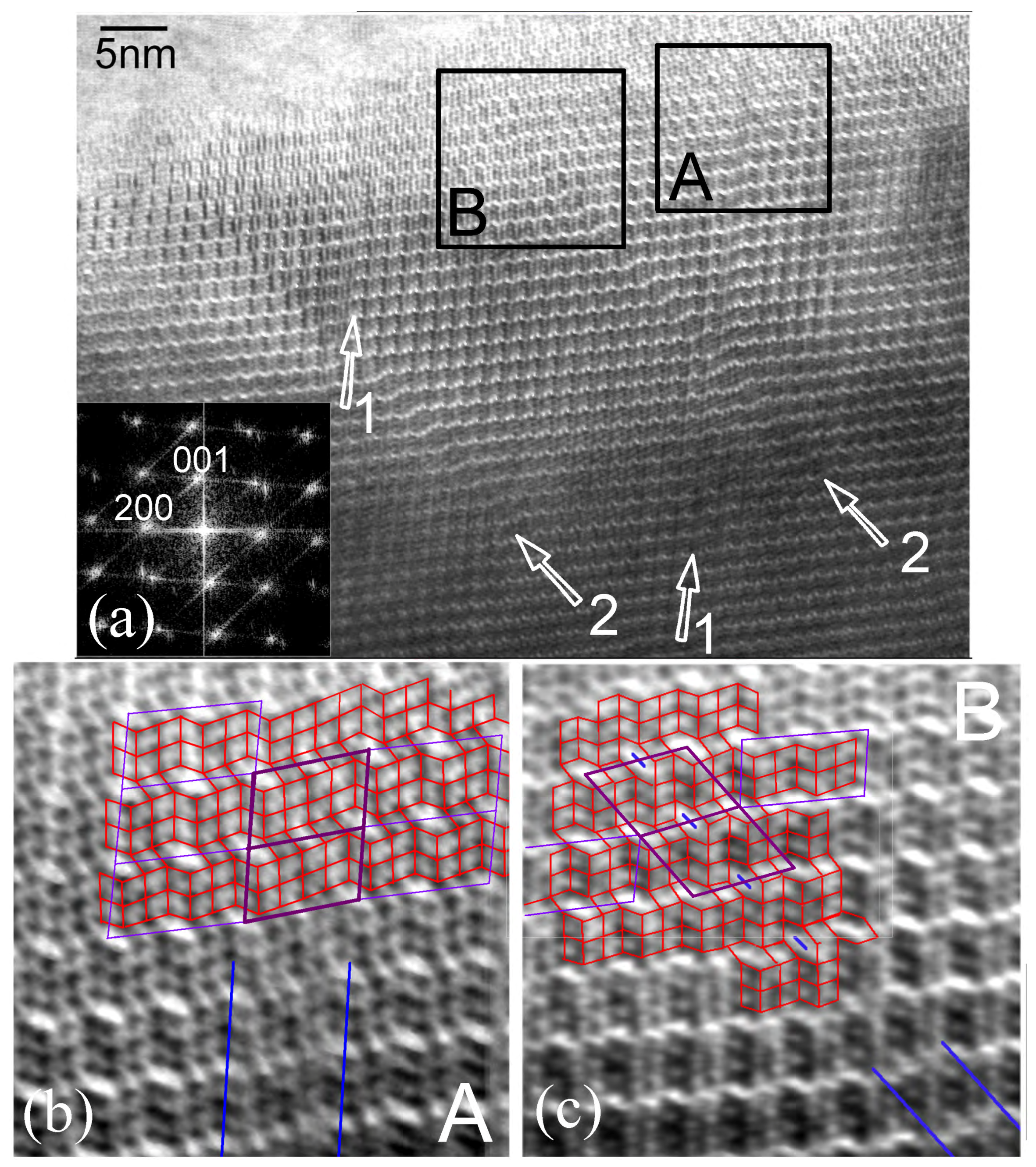
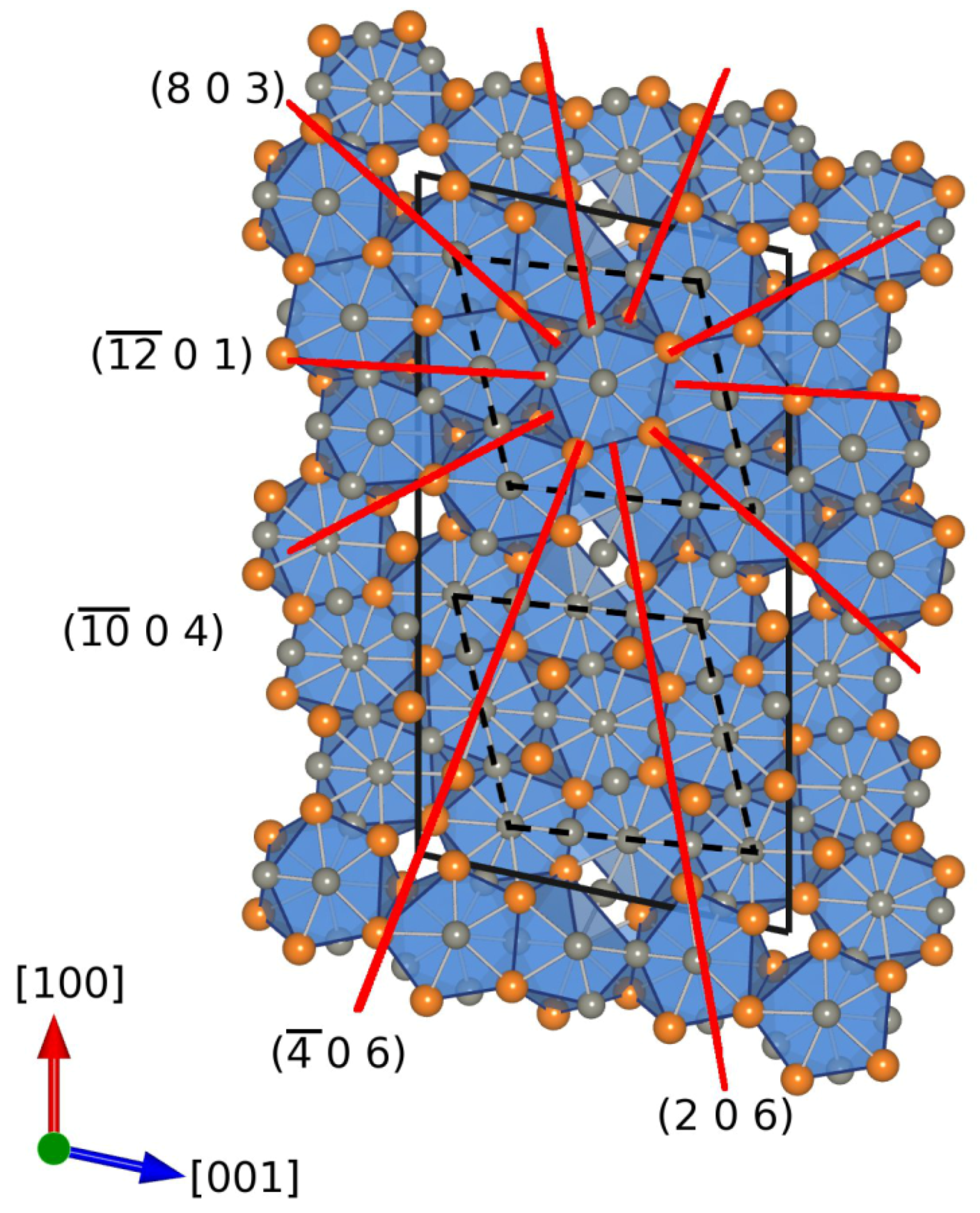
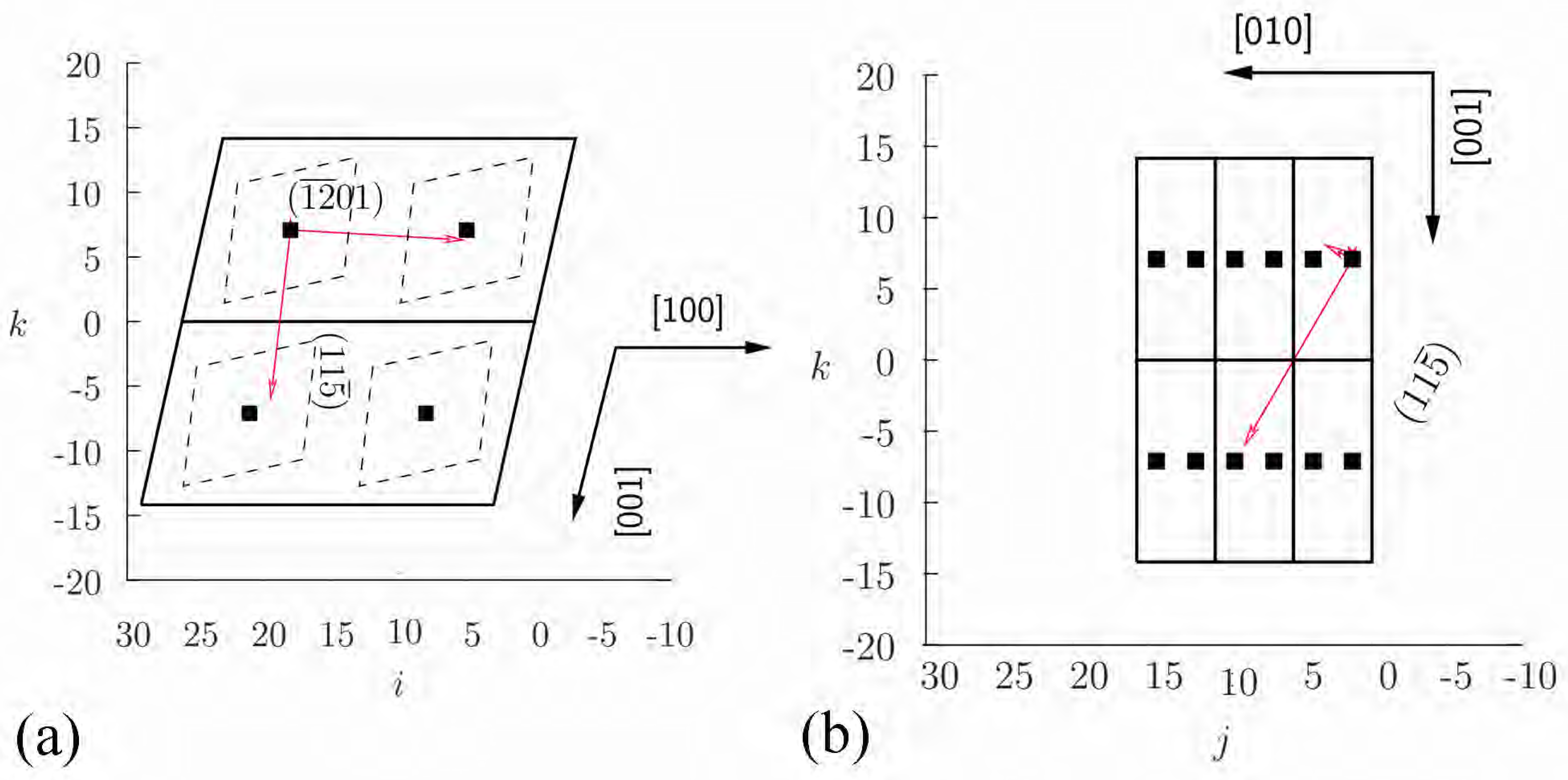
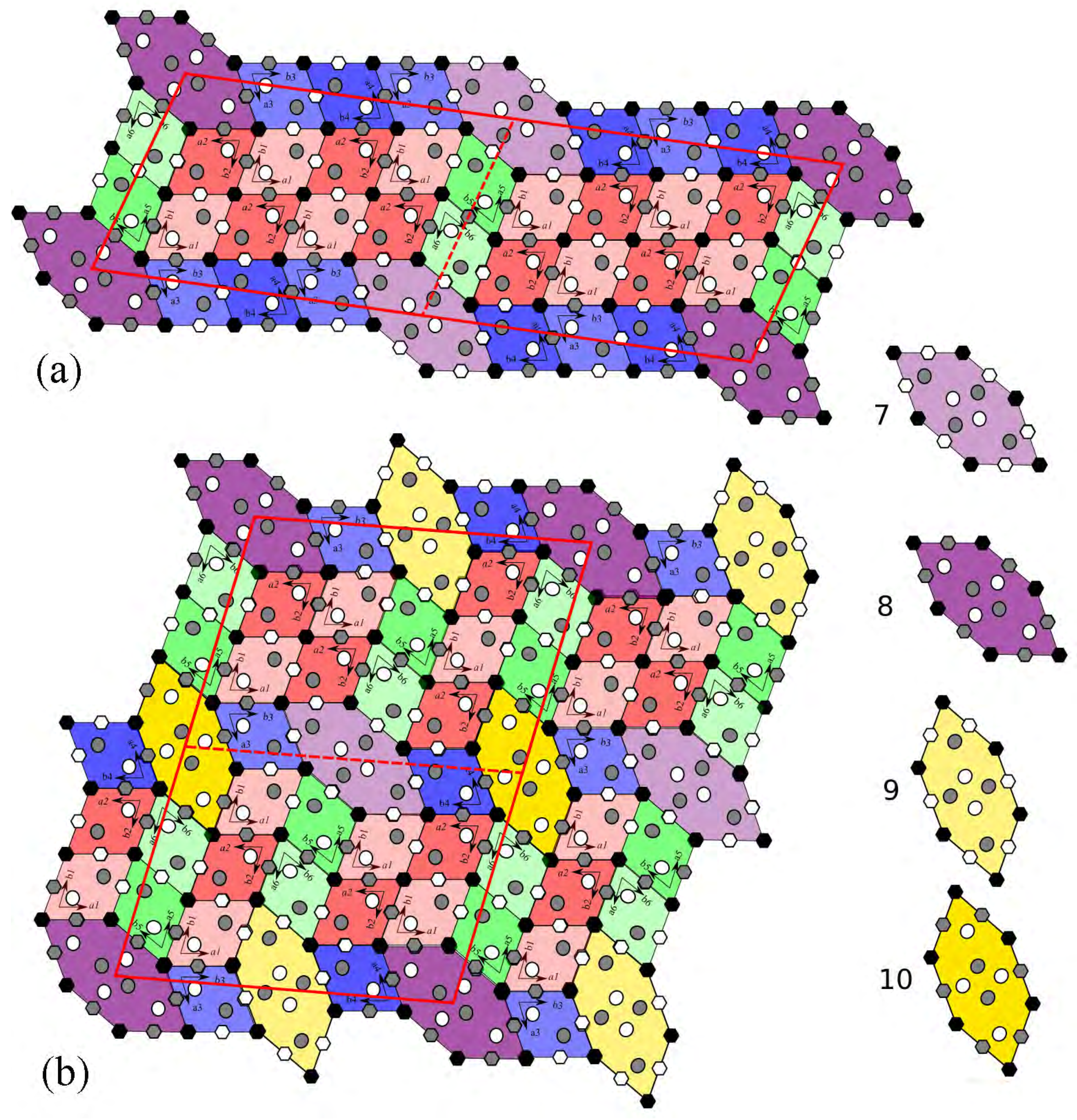
| Peak Indices | Planar Spacing (Å) | Intensity (%) | Correspondence to Icosahedral Vector | |
|---|---|---|---|---|
| Experimental | Calculated | |||
| 2 3 | 2.22 | 100 | 71 | 2f, |
| 2 0 6 | 2.20 | 89 | 67 | 2f |
| 1 5 | 2.24 | 69 | 100 | 2f, 5f |
| 2 1 | 2.24 | - | 16 | 2f, |
| 0 1 | 2.16 | 54 | 72 | 2f |
| 1 6 | 2.16 | - | 8 | |
| 6 2 1 | 2.16 | - | 17 | 2f, |
| 1 2 | 4.22 | 50 | 34 | 2f, |
| 5 1 4 | 2.34 | 44 | 58 | 2f, 5f |
| 0 0 3 | 4.64 | 43 | 60 | |
| 1 2 | 2.49 | 33 | 31 | 2f, 5f |
| 1 5 | 2.49 | - | 32 | 2f, 5f |
| 9 1 1 | 2.36 | 33 | 49 | 2f, 5f |
| 2 3 | 2.10 | 33 | 39 | |
| 1 1 | 4.39 | 31 | 41 | 2f |
| 0 6 | 2.35 | 31 | 35 | 2f |
| 0 4 | 2.30 | 18 | 28 | 2f |
| 4 2 3 | 2.08 | 15 | 15 | 2f, |
| 8 0 3 | 2.39 | 14 | 20 | 2f |
| 0 2 0 | 2.62 | - | 8 | 5f |
| Variant | Plane | d (hkl) |
|---|---|---|
| 1 | (1 1 ) | 2.525 |
| ( 0 1) | 2.159 | |
| (0 2 3) | 2.291 | |
| 2 | (2 0 6) | 2.239 |
| ( 9 1 ) | 2.491 | |
| ( 2 1) | 2.239 | |
| 3 | ( 0 4) | 2.303 |
| (1 1 1) * | 2.381 | |
| ( 1 ) | 2.370 | |
| 4 | ( 0 6) | 2.380 |
| (9 1 1) | 2.374 | |
| ( 6 1) | 2.165 | |
| 5 | (8 0 3) | 2.412 |
| ( 1 5) | 2.255 | |
| ( 4 2 ) | 2.228 |
| Variant 1 | (023) | ||
| 92.585 | 90.066 | ||
| 91.66 | |||
| Variant 2 | (206) | ||
| (206) | 90.958 | 92.4 | |
| 92.793 | |||
| Variant 3 | |||
| 89.396 | 87.076 | ||
| 87.722 | |||
| Variant 4 | (911) | ||
| 89.035 | 86.696 | ||
| ( 911) | 82.748 | ||
| Variant 5 | (803) | ||
| (803) | 90.341 | 90.669 | |
| 96.247 |
© 2018 by the authors. Licensee MDPI, Basel, Switzerland. This article is an open access article distributed under the terms and conditions of the Creative Commons Attribution (CC BY) license (http://creativecommons.org/licenses/by/4.0/).
Share and Cite
Singh, A.; Rosalie, J.M. Lattice Correspondence and Growth Structures of Monoclinic Mg4Zn7 Phase Growing on an Icosahedral Quasicrystal. Crystals 2018, 8, 194. https://doi.org/10.3390/cryst8050194
Singh A, Rosalie JM. Lattice Correspondence and Growth Structures of Monoclinic Mg4Zn7 Phase Growing on an Icosahedral Quasicrystal. Crystals. 2018; 8(5):194. https://doi.org/10.3390/cryst8050194
Chicago/Turabian StyleSingh, Alok, and Julian M. Rosalie. 2018. "Lattice Correspondence and Growth Structures of Monoclinic Mg4Zn7 Phase Growing on an Icosahedral Quasicrystal" Crystals 8, no. 5: 194. https://doi.org/10.3390/cryst8050194
APA StyleSingh, A., & Rosalie, J. M. (2018). Lattice Correspondence and Growth Structures of Monoclinic Mg4Zn7 Phase Growing on an Icosahedral Quasicrystal. Crystals, 8(5), 194. https://doi.org/10.3390/cryst8050194





